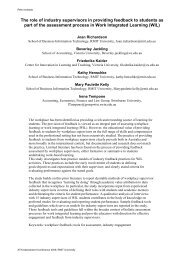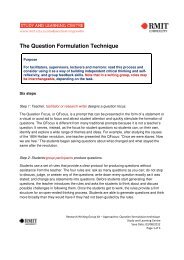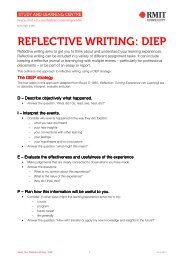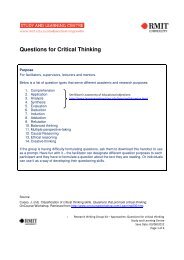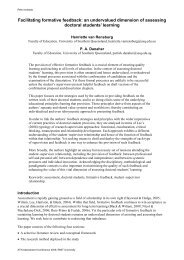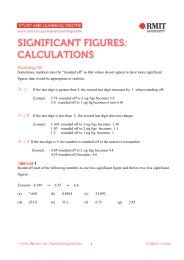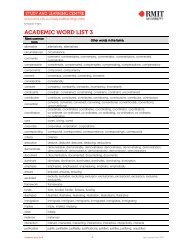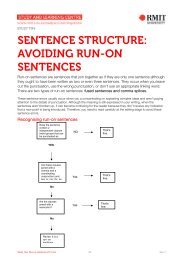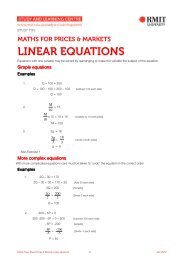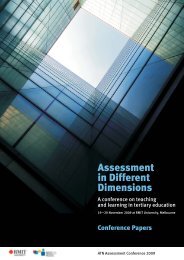student feedback and leadership - Office for Learning and Teaching
student feedback and leadership - Office for Learning and Teaching
student feedback and leadership - Office for Learning and Teaching
You also want an ePaper? Increase the reach of your titles
YUMPU automatically turns print PDFs into web optimized ePapers that Google loves.
Part B: Building Leadership Capacity - DSC: Property, Construction & Project Management ART Report<br />
<strong>student</strong> learning. The lecturer running the course sought alternative higher<br />
quality spaces to use. In the investigation, he observed how TAFE programs<br />
approached similar exercises. This lead to the discovery of an excellent<br />
purpose built <strong>and</strong> fully equipped facility complete with tutors. There was<br />
sufficient spare capacity to accommodate our higher education <strong>student</strong>s.<br />
The lecturer sought <strong>and</strong> was successful in gaining Dual Sector LTIF funding<br />
<strong>for</strong> a trial using TAFE facilities. Instead of an internal CAD teaching series<br />
of three 2 – hour lectures followed by individual work in the CAD laboratories,<br />
the Dual Sector LTIF initiative was used <strong>and</strong> CAD teaching was outsourced<br />
to the School of Design in TAFE. The School of Design conducted the CAD<br />
training in six 4 – hour workshops, held at the TAFE Brunswick Campus<br />
CAD training rooms. Each workshop contained a maximum of 19<br />
<strong>student</strong>s, so the 220 <strong>student</strong>s were divided into 12 workshop groups.<br />
Outline the stages of action taken <strong>and</strong> how it was reflected in the action<br />
research cycle process ( Plan, Act, Observe, Reflect)<br />
1154 – An external industry person, a past graduate of the Program,<br />
was invited by the Course Coordinator to conduct the case study lectures.<br />
RMIT Property Services Group were invited to contribute to lectures, as the<br />
case study is <strong>for</strong> RMIT. Several meetings were held <strong>for</strong> the course contributors,<br />
to plan the course, assessment, <strong>and</strong> course delivery. In the first lecture<br />
<strong>student</strong>s were briefed regarding the reflective journals, the case study, <strong>and</strong> how<br />
they could provide <strong>feedback</strong> through undertaking this work. The Course Team<br />
met briefly after each lecture <strong>and</strong> reviewed the success <strong>and</strong> progress of the<br />
course. Students were challenged in each lecture to provide verbal <strong>feedback</strong>,<br />
as well as making an entry in their reflective journal. At the end of the semester,<br />
after assessment was completed, <strong>and</strong> <strong>feedback</strong> given to the <strong>student</strong>s<br />
regarding their reports, reflective journals <strong>and</strong> presentations, the Course<br />
Team met <strong>for</strong> a debriefing <strong>and</strong> evaluation session.<br />
1107 – Several meetings were held <strong>for</strong> the Course design team, to set up<br />
the provision of the TAFE CAD teaching component of the course. The CAD<br />
workshops were conducted at the TAFE Brunswick campus, <strong>for</strong> six out of<br />
the total twelve weeks of Semester One. Students from past years of CAD<br />
teaching were consulted regarding how they felt it could be improved, <strong>and</strong><br />
new <strong>student</strong>s <strong>for</strong> BUIL1107 did an expectations survey in Week One. Students<br />
went from preparing CAD drawings to undertaking conventional hard-copy<br />
drawings throughout the semester, to experience both modes. At the end of<br />
the semester <strong>student</strong>s did a follow-up to the expectations survey, to give their<br />
experiences <strong>and</strong> to confirm or otherwise whether their expectations were met.<br />
The Course Team reviewed the <strong>student</strong>s’ results <strong>for</strong> both CAD <strong>and</strong> traditional<br />
drawings, <strong>and</strong> also reviewed the design of the course at a final meeting. It was<br />
decided at this meeting to provide some further specialist 3D CAD training<br />
in Semester 2 to those <strong>student</strong>s interested. This was a result of <strong>student</strong><br />
<strong>feedback</strong> stating they would like to do more CAD in the future.<br />
In addition, several items in some of the School’s learning spaces were<br />
identified as badly needing changing or upgrading. This involved providing<br />
new chairs <strong>and</strong> tablets in two learning spaces <strong>and</strong> having “SmartBoard”<br />
technology installed in the same spaces. Internal School funding was<br />
used <strong>for</strong> these purposes.<br />
How have <strong>student</strong>s been involved in the project?<br />
Students were involved via focus groups, reflective journal submissions <strong>and</strong><br />
in<strong>for</strong>mal discussions.<br />
Page 123



